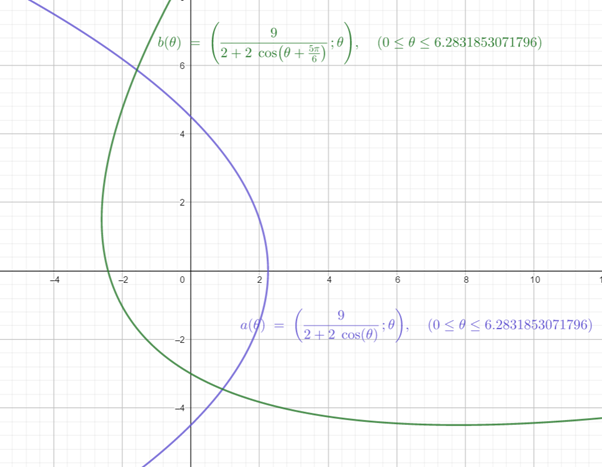
a.
To find: the eccentricity and directrix of the conic.
a.
Answer to Problem 40E
The eccentricity is
Explanation of Solution
Given information:
The polar equation is
Calculation: to find the eccentricity and directrix, first compare the polar equation with the standard equation,
The standard equation is
Now, convert the polar equation in form of standard form of equation,
By comparing both polar equation,
Thus, the eccentricity of the conic is
And the directrix of the conic is
b.
To find: the polar equation after rotating the conic.
b.
Answer to Problem 40E
The polar equation of conic is
Explanation of Solution
Given information:
The polar equation is
Calculation: to find the polar equation, substitute
Thus, the polar equation is
c.
To draw: the original conic and after rotating.
c.
Explanation of Solution
Given information:
The polar equation is
Graph: to draw the conic, use the plotting point method,
By using the above table, and the graph of the conic after rotating can be obtained as:

Interpretation: from the above graph it can be observed that the rotating graph can be obtained by rotate the original graph
Chapter 11 Solutions
Precalculus: Mathematics for Calculus - 6th Edition
 Calculus: Early TranscendentalsCalculusISBN:9781285741550Author:James StewartPublisher:Cengage Learning
Calculus: Early TranscendentalsCalculusISBN:9781285741550Author:James StewartPublisher:Cengage Learning Thomas' Calculus (14th Edition)CalculusISBN:9780134438986Author:Joel R. Hass, Christopher E. Heil, Maurice D. WeirPublisher:PEARSON
Thomas' Calculus (14th Edition)CalculusISBN:9780134438986Author:Joel R. Hass, Christopher E. Heil, Maurice D. WeirPublisher:PEARSON Calculus: Early Transcendentals (3rd Edition)CalculusISBN:9780134763644Author:William L. Briggs, Lyle Cochran, Bernard Gillett, Eric SchulzPublisher:PEARSON
Calculus: Early Transcendentals (3rd Edition)CalculusISBN:9780134763644Author:William L. Briggs, Lyle Cochran, Bernard Gillett, Eric SchulzPublisher:PEARSON Calculus: Early TranscendentalsCalculusISBN:9781319050740Author:Jon Rogawski, Colin Adams, Robert FranzosaPublisher:W. H. Freeman
Calculus: Early TranscendentalsCalculusISBN:9781319050740Author:Jon Rogawski, Colin Adams, Robert FranzosaPublisher:W. H. Freeman
 Calculus: Early Transcendental FunctionsCalculusISBN:9781337552516Author:Ron Larson, Bruce H. EdwardsPublisher:Cengage Learning
Calculus: Early Transcendental FunctionsCalculusISBN:9781337552516Author:Ron Larson, Bruce H. EdwardsPublisher:Cengage Learning





